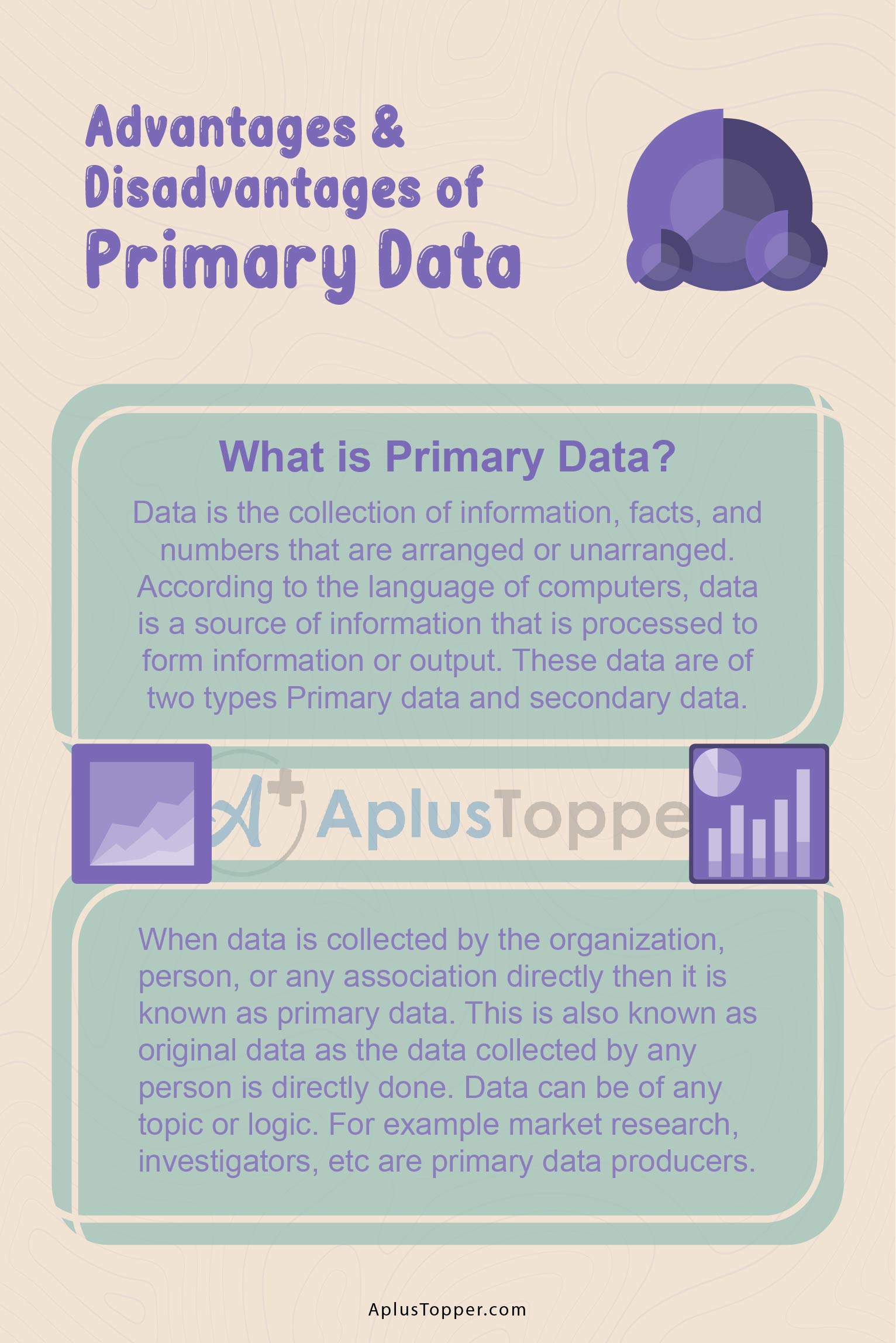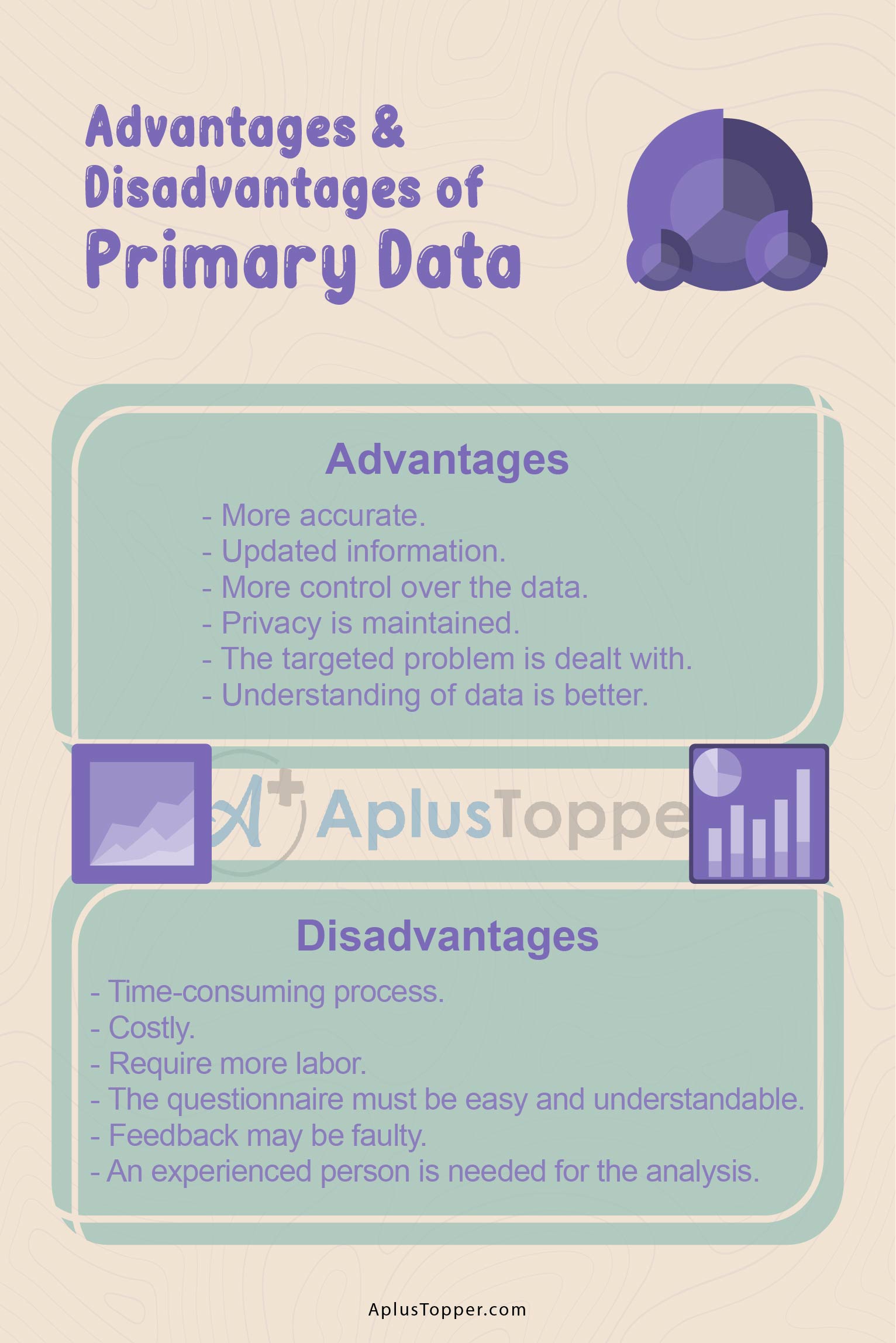Advantages and Disadvantages of Primary Data: Data is the collection of information, facts, and numbers that are arranged or unarranged. According to the language of computers, data is a source of information that is processed to form information or output. These data are of two types Primary data and secondary data. Primary data refers to first-hand information while secondary data refers to second-hand information. Without these data, no one could evaluate or study anything required for different purposes.
Students can also find more Advantages and Disadvantages articles on events, persons, sports, technology, and many more.
What do you mean by Primary Data? Advantages and Disadvantages of Primary Data 2022
When data is collected by the organization, person, or any association directly then it is known as primary data. This is also known as original data as the data collected by any person is directly done. Data can be of any topic or logic. For example market research, investigators, etc are primary data producers.
Primary data is costly as the research is carried out at its own risk and cost. Therefore primary data has its advantages as well as disadvantages. Let’s go through a few advantages and disadvantages of Primary data.
- Advantages of Primary data
- Disadvantages of Primary data
- Comparison Table for Advantages and Disadvantages of Primary Data
- FAQs on Pros And Cons of a Primary Data
Advantages of Primary Data
Now let us discuss briefly the advantages of Primary data
- More Accurate: Primary data is researched and developed by individuals giving personal attention to each of the questions they wanted to survey. People more often rely on themselves than relying on others’ data. Also, assessments could be made by individuals working on it. Therefore making data more valid and accurate. Also, it is more reliable than secondary data.
- Updated information: The data which is produced is first-hand data. No other person’s data has been used to develop information that makes the data updated and people rely on information that is more updated and recently been produced. Primary data generally is prepared through a questionnaire or personal contact thus information that is received is valid and updated.
- More Control over data: Since the person who is surveying through questionnaires or any other design can manage the data, thus he has control over the whole survey. He can manipulate or make certain updates in the questionnaire to make it more meaningful. The expert sometimes also faces difficulty as a targeted group may not easily know or understand the motive of the survey, thus little manipulation can help them to obtain correct feedback.
- Privacy is maintained: The expert who is maintaining all the survey work also maintains the secrecy of the data. It is pretty obvious that when few individuals maintain the whole survey work then mostly secrecy is maintained among them without leaking the ideas. Also, the feedback that they get is always private to surveyors.
- The targeted problem is dealt with: People who are engaged in the collection of data prepare the questionnaire and sometimes take the interview from the targeted group to obtain data. Also, the problem is addressed so that after proper feedback it could be put in the limelight and can be resolved. In this way, the program can be made productive and problems also can be easily handled.
- Understanding of data is better: The data surveyed through different designs and methods are made simple and easy to understand so that the person who is interested in data can easily understand it with a glance. Also, it becomes more effective if the feedback obtained is accurate and valid.
Disadvantages of Primary Data
- 1 Time-consuming process: The organizer of the survey and method which is used may take a lot of time to collect the data from raw sources. In secondary data, we gather information from other sources. Therefore, it takes less time. Since it is time taking sometimes it delays addressing the problem going on in the surrounding.
- Costly: The survey done is time-consuming as well as costly. For the collection of data, experts have to visit and use equipment that may cost very high. Also after obtaining feedback proper documentation is required which is again needed to take care of and involve high cost.
- Require more labor: The manpower requirement is more in the case of primary data as only one person cannot make a survey on his own or collect data single-handedly. Also, the number of men required is more and have to be paid after their work has been done.
- The questionnaire must be easy and understandable: The questionnaire prepared must be easy to understand then only the researchers may get correct and valid feedback. The researchers have to make the set of sample questionnaires in such a way or use the method or technique that may help the people to interpret it easily if not the feedback which is produced will be wrong or inaccurate.
- Feedback may be faulty: We have already learned that if the technique used by researchers will not be proper or accurate then the feedback also which is produced will be faulty or incorrect. Thus proper action and maintenance must be done so that the feedback data which is produced should be authentic.
- An experienced person is needed for the analysis: The method for collecting data, technique, and analysis must be done by an expert as only an expert can make the whole research meaningful by providing genuine facts and information. The analysis is mostly done by the researcher or an expert according to the problem found.

Comparison Table for Advantages and Disadvantages of Primary Data
| Advantages of Primary data | Disadvantages of primary data |
| More accurate | Time-consuming process |
| Updated information | Costly |
| More control over the data | Require more labor |
| Privacy is maintained | The questionnaire must be easy and understandable |
| The targeted problem is dealt with | Feedback may be faulty |
| Understanding of data is better | An experienced person is needed for the analysis |
FAQs on Pros And Cons of a Primary Data
Question 1.
What is secondary data?
Answer:
Data received from any source already researched or investigated by other researchers are called secondary data.
Question 2.
Who are researchers of primary data?
Answer:
The expert who is collecting data from raw sources by applying his techniques and method to collect data are the researchers of primary data.

